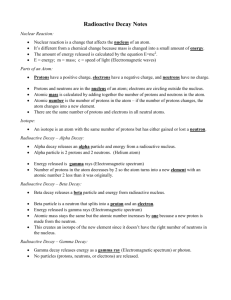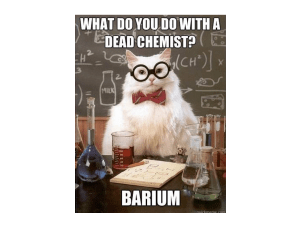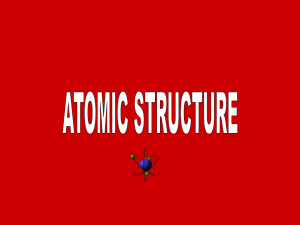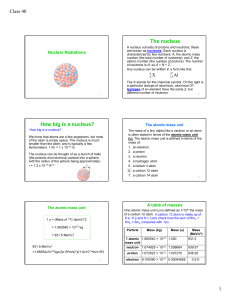Nuclear Physics Notes - Reading Community Schools
advertisement
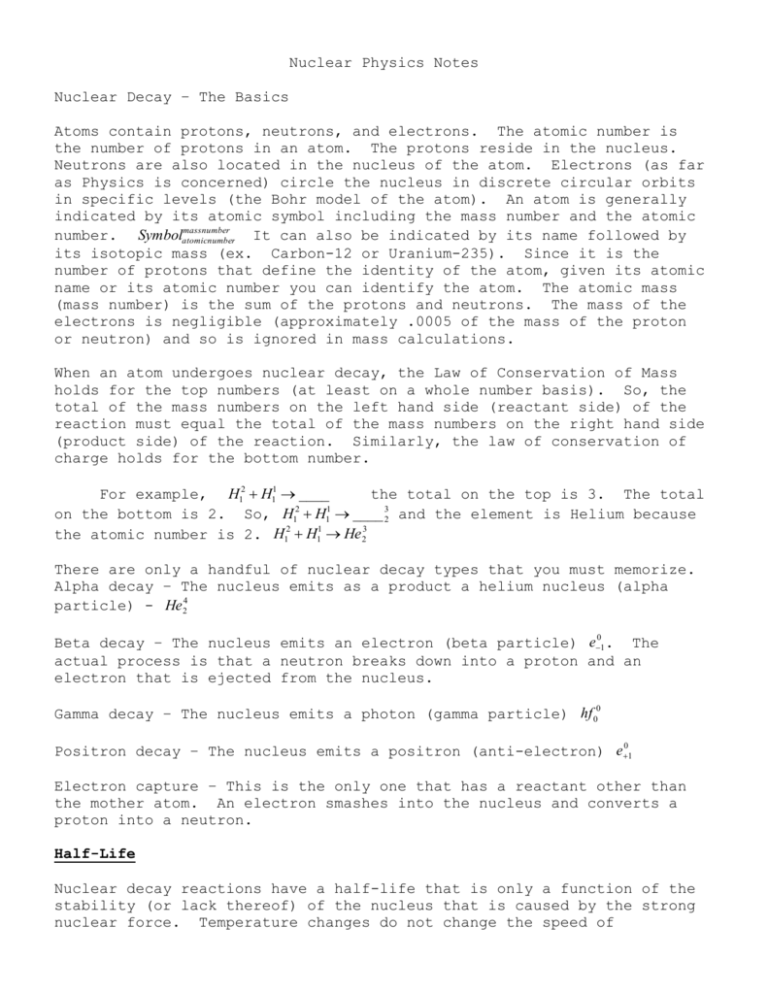
Nuclear Physics Notes Nuclear Decay – The Basics Atoms contain protons, neutrons, and electrons. The atomic number is the number of protons in an atom. The protons reside in the nucleus. Neutrons are also located in the nucleus of the atom. Electrons (as far as Physics is concerned) circle the nucleus in discrete circular orbits in specific levels (the Bohr model of the atom). An atom is generally indicated by its atomic symbol including the mass number and the atomic massnumber number. Symbolatomicnumber It can also be indicated by its name followed by its isotopic mass (ex. Carbon-12 or Uranium-235). Since it is the number of protons that define the identity of the atom, given its atomic name or its atomic number you can identify the atom. The atomic mass number) is the sum of the protons and neutrons. The mass of the (mass electrons is negligible (approximately .0005 of the mass of the proton or neutron) and so is ignored in mass calculations. When an atom undergoes nuclear decay, the Law of Conservation of Mass holds for the top numbers (at least on a whole number basis). So, the total of the mass numbers on the left hand side (reactant side) of the reaction must equal the total of the mass numbers on the right hand side (product side) of the reaction. Similarly, the law of conservation of charge holds for the bottom number. For example, H12 H11 ____ the total on the top is 3. The total 2 1 on the bottom is 2. So, H1 H1 ____ 32 and the element is Helium because the atomic number is 2. H12 H11 He 23 There are only a handful of nuclear decay types that you must memorize. Alpha decay – The nucleus emits as a product a helium nucleus (alpha particle) - He 24 0 Beta decay – The nucleus emits an electron (beta particle) e1 . The actual process is that a neutron breaks down into a proton and an electron that is ejected from the nucleus. hf 00 Gamma decay – The nucleus emits a photon (gamma particle) 0 Positron decay – The nucleus emits a positron (anti-electron) e1 Electron capture – This is the only one that has a reactant other than the mother atom. An electron smashes into the nucleus and converts a proton into a neutron. Half-Life Nuclear decay reactions have a half-life that is only a function of the stability (or lack thereof) of the nucleus that is caused by the strong nuclear force. Temperature changes do not change the speed of radioactive decay; concentrations do not affect them. follow a zero-order kinetic law. At Ao (.5) They simply t t1/ 2life Binding Energy and Einstein’s Equation Theoretically, the mass of an atom should be the sum of the masses of all the protons and the neutrons in the nucleus. So, for example a Uranium-235 atom, which has 92 protons and 143 neutrons. Its mass mass 92 * m proton 143* mneutron should equal mass 92 *1.67E 27 143*1.67E 27 ; however, its actual mass is mass 3.9245E 25kg 3.9017E-25 kg. Those numbers don’t match. What happened to the missing mass -- the MASS DEFECT?? BINDING ENERGY that holds the nucleus together in an effort to It became prevent it from blasting apart because of the strong electrical kQq repulsions ( Felectric 2 ) between the protons. This lost mass obeys the d 2 equation E mc . So for this uranium isotope, the mass defect is m 3.9245E 25 3.9017E 25 This allows the binding energy to be m 2.28E 27kg E mc 2 2.28E 27 * (3E8)2 . That may not seem like much energy, but that is E 2.052E 10J the amount of energy PER ATOM of Uranium. So, in a mole of Uranium atoms (6.02E23 atoms) there is 1.235E14J of energy or on a per gram basis that is 5.25E11 J of energy. 525,661,276,596 J of energy per gram. That’s billions of Joules of energy in one gram of Uranium. To put that in perspective, that is enough energy to lift all 6 billion people on earth (assuming an average mass of 70 kg (150 pounds))to a height of 12.5 meters (41 feet) above the ground. The power of the strong force (c2=9E16) is 10 million times stronger than the electromagnetic force (k=9E9) which is 100 PENTILLION times stronger than gravity (G=6.67E-11). It is almost incomprehensible how much energy is stored. In fact, it is the release of binding energy as light when a supermassive star goes supernova that allows the star to outshine entire galaxies (billions of stars) when it explodes.







